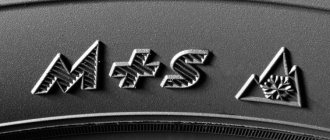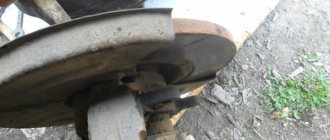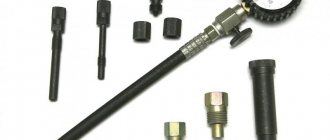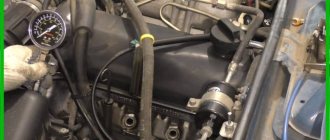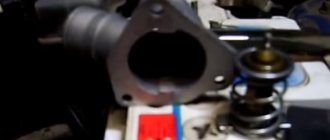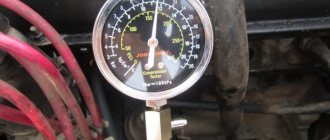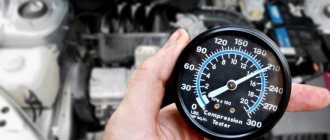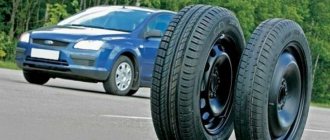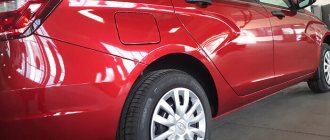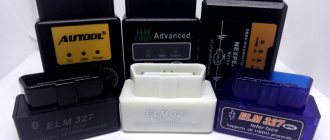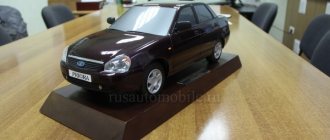Night. It's 2:30 on the clock. The side of the road in the middle of a field. The smartphone cannot find a cellular network signal. Runflat wheels, but one is empty. It turned out that even “armored” tires are not protected from side cuts. It's all because of a hole in the middle of the road and my own disc. There is no full-fledged spare tire in the trunk, no spare parts, no tools for replacement. Yes, a problem with an asterisk. It seems like an unlikely scenario. But experienced motorists will confirm that anything can happen on the road. After such an incident, you will inevitably start looking for, if not a full-fledged spare tire, then at least a replacement one. The right decision.
Subscribe to our Zen
What is a car dock?
The wheel is a lightweight version of a standard car wheel. Its name is telling, because it is intended only to “drive” to the nearest tire shop, repair the base tire, install it on the car and continue driving. On the one hand, a rolling wheel is not particularly different from a full-fledged wheel in terms of design. On the other hand, it has a lightweight form factor, which is designed to not take up too much space in the special storage compartment under the luggage compartment floor or in the luggage compartment itself if permanent storage is not intended.
The rolling disk is most often made not of light alloy metals, but of steel. This wheel has smaller dimensions than a regular one, so this solution is needed to provide it with the necessary strength. Other materials that are lighter but can be just as reliable in a compact format are generally not used for economic reasons. The wheel is approximately the same size as a full wheel in height. But it is narrower to take up less space in a horizontal position. Accordingly, the tire on the road is not standard, but “special”. It is narrower and, as practice shows, not of very high quality, because it is needed until the nearest tire service.
The re-roller has much more modest dimensions than a full-fledged wheel | Car Insurance
Repair kit
A tire repair kit can be extremely saturated, but in reality it is often useless.
It will not heal a severe side cut. Finding a small puncture in the field is not always an easy task. And how many people will undertake to patch a hole, say, in the rain or in the cold? A tire repair kit can be extremely saturated, but in reality it is often useless. It will not heal a severe side cut. Finding a small puncture in the field is not always an easy task. And how many people will undertake to patch a hole, say, in the rain or in the cold?
A repair kit instead of a spare tire is becoming a very common option and is slowly moving from the premium segment to simpler cars. Although tinkering with wheel repair in our specific country, where sometimes there is no roadside, is a task for a keen connoisseur. However, it is in any case easier to imagine the owner of a Kia Rio with a “plug” and glue in his hands than a driver of a Porsche or Cadillac.
If the “Run Flat” technology (literally, “run flat”) reaches budget cars, it won’t be for a long time. Tires with reinforced sidewalls and a bead ring that prevents a flat tire from sliding off the rim are a good thing in themselves. They are less susceptible to damage in principle, and with a puncture they can easily withstand a hundred kilometers. That's what they were invented for.
What criteria are used to choose a car repair kit?
◉ Size. When choosing a tire, some are immediately mistakenly puzzled by the quality of the rubber that is used on it. As practice shows, this does not matter much, since such a wheel is intended only for temporary use. There is also usually no need to worry about the bolt pattern of a replacement wheel, because in an online store or at a regular retail outlet you just need to indicate compatibility with a specific car. But the size is a little different story. It is important that it differs from all other wheels by no more than 1 inch (2.54 cm) in any direction. Otherwise, the load on the vehicle's chassis will greatly increase.
The replacement tire should not differ in size from a full-fledged spare tire by more than an inch | Kwik Fit
◉ Protector. In domestic realities, it is advisable to choose a tire tread with a claim to an all-season format. Of course, it is important to understand that the rubber that will be used on such a wheel will have a completely different composition than that of a regular tire. However, this approach will ensure acceptable grip at any time of the year.
How far can you travel on a dock?
Much depends on the difference in diameters of the standard and re-rolling wheels, as well as on the location of its installation, on driving or free-rolling wheels. Travel conditions can also be different, everything affects the speed, road condition, tire pressure.
Under ideal conditions, even a typical tire with a tread of minimal thickness and not of the highest quality can travel several thousand kilometers before wearing out completely.
It is much more important not to exceed the speed; it is usually indicated in the instructions and is no more than 80 km/h, even if a higher threshold is indicated on the tire.
Wear and tear accelerates significantly with increasing speed, especially due to overheating. Emergency braking will also lead to rapid destruction. Not only is this unsafe, the car is literally thrown to the sides, much earlier than the permitted 80 km/h, but the tread will also disappear instantly and unevenly.
In any case, you only need to go to the nearest service station. Such travel is also limited by law; according to the rules, tires on the same axle must be identical. That is, such a trip is already an exception, and means that the car gets to the repair site with all precautions.
What tools are needed to install the dock?
◉ Jack. It is necessary to lift the car to change a tire. If a specific model does not have a spare tire or a stowage rack at all, which is becoming more and more common in modern compact cars, then there cannot be a jack from the factory. Apparently, manufacturers are confident that in case of a puncture it will be easier to call a tow truck.
It is important to acquire not only a spare tire, but also a jack | The Home Depot
◉ Wrench. As practice shows, many people forget about it. Yes, it is also usually not included in the kit if a stowage or spare tire is not provided. Moreover, if the car was purchased on the secondary market, it is better to also check the complete set of tools, because the previous owner can “carefully” lay out any of the devices.
◉ Secret key. If the disks are secured with locks, you also need a key for them. Some drivers take it with them only when they need to replace winter tires with summer tires, and vice versa. Without such a device, it will not be possible to change the wheel yourself, even with a strong desire. It’s generally better not to lose this thing under any circumstances.
◉ Pump or compressor. Since the tire, like a full-fledged spare wheel, is used quite rarely, the pressure in it will clearly not be necessary for normal movement. That is why, if the main wheel is damaged, it will have to be inflated to the level stated by the manufacturer. Either a pump or a compressor will do.
A compressor is a must-have device for any car.
Run Flat
Among runflat tires with reinforced sidewalls, there are relatively affordable models.
But not everywhere in Russia they are fully suitable and provide a guarantee of travel - the distances between tire fitting points in some places reach 200–300 km. Among runflat tires with reinforced sidewalls, there are relatively affordable models. But not everywhere in Russia they are fully suitable and provide a guarantee of travel - the distances between tire fitting points in some places reach 200–300 km.
Nuances when installing a dock and driving on it
◉ Position of dokatka. It is highly undesirable to install a dokatka on drive wheels. Therefore, if the front wheel on a front-wheel drive is damaged, it is best to rearrange the whole one and install the spare one back. With rear-wheel drive it is more difficult, because the front wheels bear a higher load, and the rear wheels push the vehicle. In this case, you will have to make a compromise: either risk puncture and sacrifice controllability, or give up normal grip. As for all-wheel drive, it is better to put the wheel in the rear to reduce the load on it when driving.
◉ Pressure in the dock. Since it has a noticeably smaller width, it definitely needs to be upgraded to higher levels. Usually the normal pressure for re-rolling is 4–4.2 atmospheres. However, it is better to familiarize yourself with the markings, which should be indicated either on the tire or on the shipping packaging.
Recommendations for using the document are usually depicted on the document itself | Car Insurance
◉ Movement speed. When moving on the dock, it is important to observe the speed limit. It is generally recommended not to exceed 60 kilometers per hour. Due to possible issues with controllability, you need to move more carefully when rolling back. It is also better to turn on the hazard signal to draw the attention of other road users.
Rules for using the finishing wheel
In addition, riding a dokatka is still an adventure, and a very dubious one at that. This is because it has a smaller grip area with the road surface than a standard wheel.
And if you suddenly had to use such a re-roll, then you should not drive faster than 50-60 km/h, not forgetting about a moderate driving style without sudden maneuvers and cutting.
If a motorist who is overly confident in his own driving skills suddenly decides to go on business with such a spare tire, putting himself and other road users at risk, then he should be prepared for the fact that traffic police officers may issue him a fine of 500 rubles. (Part 1 of Article 12.5 of the Code of Administrative Offenses of the Russian Federation).
What are the pros and cons of a spare wheel versus a spare wheel?
Advantages:
⊕ Minimum dimensions. Of course, most people prefer a spare tire to a full-fledged spare tire precisely because of its modest dimensions. This is important so that it does not take up much space in the trunk if the standard storage compartment is not intended or gas or any other auxiliary equipment is installed in it.
Dokatka greatly saves space inside the car
⊕ Light weight. Due to the fact that it is noticeably smaller than the spare wheel, it does not weigh as much. This, albeit insignificantly, will definitely have a positive effect on fuel consumption both in city mode and on the highway. However, in the first case, due to the close proximity of tire shops, it is not necessary to carry a tire kit with you at all.
⊕ Easy to use. Since the spare tire is noticeably lighter than a full-fledged spare tire, it is potentially easy to install on a car. However, if you have to change the location of the wheels so that the spare one is not on the drive axle, then this advantage immediately disappears and turns into a noticeable disadvantage.
⊕ Low cost. If you don’t have a full-fledged spare wheel or a spare wheel, then getting the latter will be much cheaper. This is not surprising, because the item is initially of lower quality and material-intensive, therefore lower in cost, as well as in retail price.
Advantages and disadvantages of a compact spare tire
Like any other product, dokatka has its advantages and disadvantages. The first include:
- Small size and compactness, allowing you not to fill the trunk to capacity.
- Light weight. Changing such a spare tire is much easier than changing a full-size wheel.
- Price tag. The cost of re-rolling is such that even a motorist with the most limited budget can afford it. And this is quite natural, given the amount of materials spent on its production.
- Easy to install/dismantle. Since this wheel is smaller and lighter, it is much easier and faster to install.
- Good prognosis for recovery. Has your dokatka lost weight? It doesn’t matter, because it costs nothing for the master to disassemble and reassemble it.
As for the shortcomings, there are also many of them. And first of all, we are talking about the following serious disadvantages:
- The light weight and dimensions of the dokatka directly affect the safe operation of the vehicle.
- Fragility and low reliability. Due to the fact that tires are made from the cheapest materials, it is not surprising that they fail much faster than conventional wheels. It is worth noting that cutting/piercing such a spare tire is much easier than a full-size one.
In principle, the dokatka has more advantages than disadvantages, but this does not mean that you need to choose just such an alternative. And if you have extra money, then it always makes sense to purchase a full-size wheel as a spare, and not a smaller copy of it in a budget version.
What is the difference between a rolling wheel and a regular wheel?
The emergency wheel has a lightweight design, since it is used for emergency replacement of a damaged wheel of the main set in unfavorable conditions: on the highway, during rain or at low air temperatures.
Weight
The weight of the re-roller is significantly reduced compared to the weight of the main set wheel. The reason for this is:
- the stamped disk has a lightweight design and smaller width;
- nominal tire width is 1/3 smaller;
- The tire thickness is smaller due to a small layer of fabric cord and the height of the tread.
This design of the dock is designed to reduce the space occupied in the trunk of a car and increase ease of installation.
Standard sizes
The outer diameter of the emergency wheel must match the size of the wheels of the work kit.
In emergency cases, it is possible to install wheels with a difference of one unit, for example, instead of R14, install R13 or R15, but you should be prepared for a significant decrease in the maneuverability of the car and increased wear of suspension parts.
Quality
The emergency wheel is manufactured and tested in accordance with the methods established by GOST R 41.64 - 99 “Uniform regulations concerning the official approval of vehicles equipped with spare wheels/tires for temporary use.” Consequently, the quality of the ride meets safety requirements, and driving such a car is quite comfortable, but subject to strict adherence to the speed limit and time of use.
Strength
The method and materials for manufacturing a spare wheel provide for a maximum re-rolling mileage of 2500 – 3000 km, depending on the manufacturer. Until this value is reached, the emergency wheel meets all strength requirements and ensures safe movement.
Price
The price of the emergency wheel is reduced due to:
- disc production method - stamping and welding;
- disc material – carbon steel;
- simplified tire cord manufacturing technology;
- absence of additional inserts in the tire structure.
The cost of re-rolling a middle-class car varies from 600 to 2,500 rubles.
